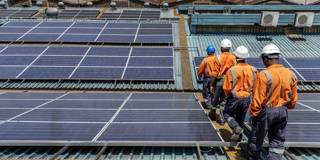While some low- and lower-middle-income countries have regained access to financial markets, liquidity pressures have continued to increase. Immediate debt relief remains the best way to stabilize developing economies and enable them to pursue climate-related investments.
PARIS/BASEL – For the first time in two years, some low-income and lower-middle-income countries (LMICs) can access the bond market. But many others remain still in dire need of liquidity and face punishing interest rates. Amid this ongoing crisis, the Finance for Development Lab’s proposal for a “liquidity bridge” that would enable developing economies to extend the maturity of their debts by 5-10 years and allocate resources toward climate mitigation and adaptation remains as necessary as ever.
The good news is that LMICs’ external debt ratios remain relatively modest, at around half the level before the Highly Indebted Poor Countries debt-reduction initiative. In 2023, only one country, Ethiopia, defaulted on a $1 billion Eurobond.
The bad news is that liquidity pressures on LMICs have continued to increase. After 2010, a spike in medium-term loans has enabled developing countries to fund critical infrastructure projects. Typically, these loans would be rolled over, but this became impossible as major economies embarked on quantitative tightening, causing a sharp rise in interest rates and net capital outflows. The liquidity crisis has been compounded by a series of exogenous shocks: reduced flows from China, the lingering effects of the COVID-19 pandemic, and a surge in fuel and food prices.

PARIS/BASEL – For the first time in two years, some low-income and lower-middle-income countries (LMICs) can access the bond market. But many others remain still in dire need of liquidity and face punishing interest rates. Amid this ongoing crisis, the Finance for Development Lab’s proposal for a “liquidity bridge” that would enable developing economies to extend the maturity of their debts by 5-10 years and allocate resources toward climate mitigation and adaptation remains as necessary as ever.
The good news is that LMICs’ external debt ratios remain relatively modest, at around half the level before the Highly Indebted Poor Countries debt-reduction initiative. In 2023, only one country, Ethiopia, defaulted on a $1 billion Eurobond.
The bad news is that liquidity pressures on LMICs have continued to increase. After 2010, a spike in medium-term loans has enabled developing countries to fund critical infrastructure projects. Typically, these loans would be rolled over, but this became impossible as major economies embarked on quantitative tightening, causing a sharp rise in interest rates and net capital outflows. The liquidity crisis has been compounded by a series of exogenous shocks: reduced flows from China, the lingering effects of the COVID-19 pandemic, and a surge in fuel and food prices.